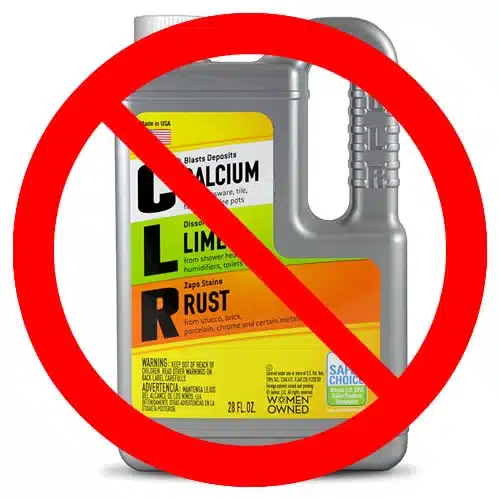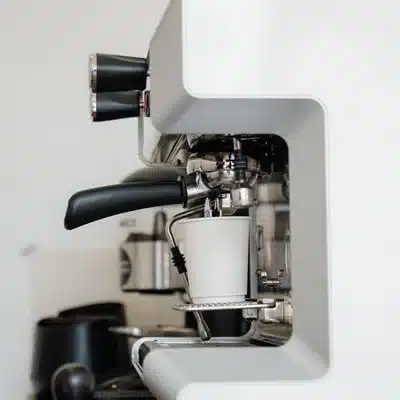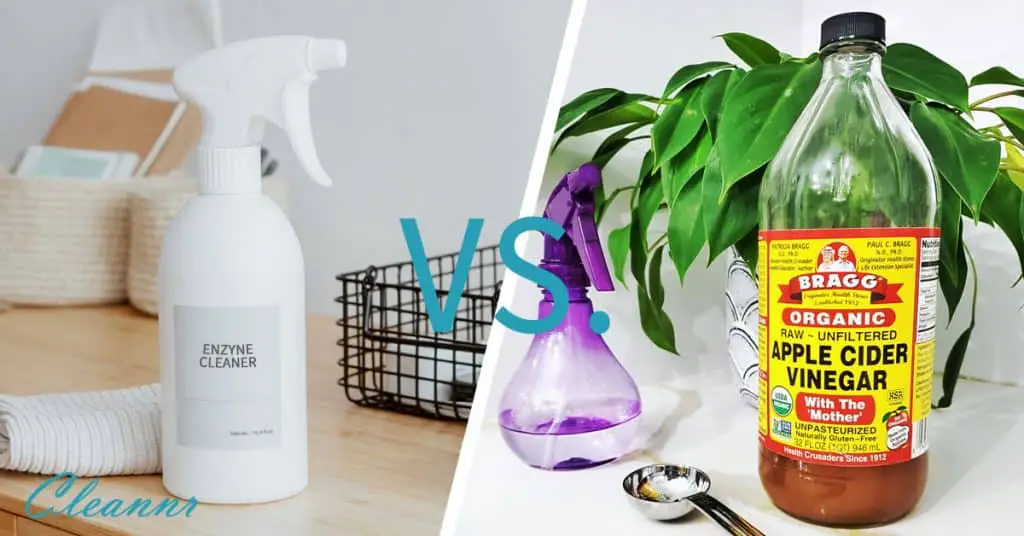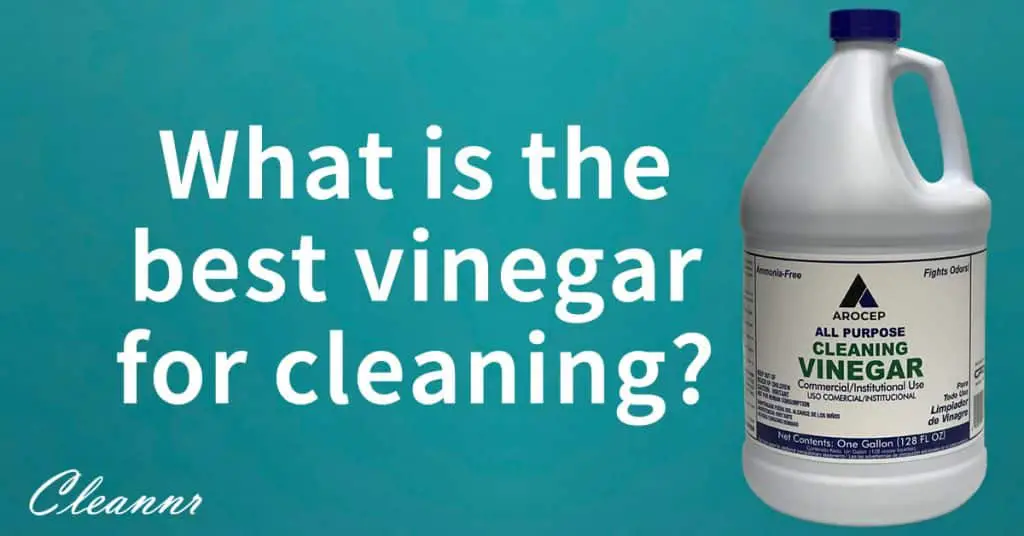While CLR is known as an effective household cleaning product it still has some limits. Did you know that there are things you should not use CLR on? Since this is a strong cleaning agent, surfaces could be damaged easily. So, what should you not use CLR on?
Avoid getting CLR on wooden surfaces, clothing, wallpaper, or carpeting. Also, avoid using it on natural stones such as marble and granite. Do not use CLR to clean copper or brass. All mentioned surfaces can be seriously damaged by CLR.
In the following paragraphs, you’ll learn what should you not use CLR on and how to keep your home safe and clean. Read these hacks and tips carefully and avoid costly mistakes. Let’s check it together!
Contents
- What should you not use CLR on? The major DON’Ts
- What happens if you leave CLR on too long?
- Can you use CLR in a coffee maker?
- Can I clean cast iron with CLR?
- Can I use CLR to clean my tankless water heater?
- Can CLR be used to clean stains from rugs?
- Will CLR eat through metal?
- Does CLR remove hard water stains?
- Does CLR remove hard water stains from glass?
- Is CLR safe for septic?
- FAQs
- Conclusion
What should you not use CLR on? The major DON’Ts

Several mistakes can be made when using CLR, and some of them can be dangerous. The most important thing to remember is that you should always put your own personal safety above all else.
If you’re not sure about something, don’t do it! You can always call the manufacturer’s customer service line for more information.
Here are some of the most important DON’Ts related to the use of CLR:
1. Don’t mix CLR with other household cleaning agents
When you use CLR, it can react with other household products to create toxic fumes. The best way to avoid this is to keep all of your cleaning products in separate containers and make sure they never touch.
When combined, these chemicals can form dangerous new compounds that are even more harmful than the individual ingredients. The worst thing is that you may not be aware of their presence until it’s too late.
2. Don’t use CLR before you read the declaration
You just have to make sure that you’re using it correctly. That starts with reading the instructions on the packaging.
That way, you can avoid making common mistakes like using too much of the product or not letting it air out for a full 24 hours before cleaning up after yourself.
3. Don’t use CLR in a space with no ventilation
When you use CLR, the fumes can be dangerous to breathe in. To make sure you’re using it safely, always open your windows and doors before using it.
If you do need to use it in a closed space, make sure you have a window or door open for ventilation.
4. Don’t let CLR sit for too long
You mustn’t let CLR sit in your pipes for too long. After all, the acid can eat away at the inside of your pipes, and that’s no good. You should be sure to flush out the material quickly after using it.
5. Don’t spray CLR around the house
CLR is a caustic chemical product and it can cause serious health problems if you inhale or ingest it. It’s also not very good for your hands, so please wash them thoroughly after handling them.
When you use CLR, you should wear safety goggles, rubber gloves, and a mask to avoid getting the product in your eyes, nose, or mouth.
6. Don’t use undiluted CLR
Chemical-based cleaners like CLR are designed to clean and remove mildew, lime deposits, and rust from tubs, sinks, and other surfaces.
They’re also pretty strong stuff – so strong that they can actually eat through metal if you use too much of it on your bathtub or sink.
That means that if you use undiluted CLR, it will not only remove the grime but also eat away at your fixtures’ finish and potentially damage them permanently.
What happens if you leave CLR on too long?
So, if you’re wondering what happens if you leave CLR on too long, you have to be aware that CLR is a highly acidic agent. CLR is a great cleaner for your pipes, but if you leave it on for too long, it can damage your pipes.
The best way to avoid damaging your pipes with CLR is to keep an eye on the time and make sure that you’re not leaving the product on for longer than recommended.
For example, if you’re using CLR on your toilet bowl, the instructions will tell you to let the product sit in contact with the toilet bowl for no longer than 15 minutes.
If it’s been longer than that, then you should use a sponge or towel to wipe off any excess product and finish cleaning up after yourself!
Can you use CLR in a coffee maker?

Coffee makers are made of plastic and metal, so they’re not as susceptible to CLR as other appliances might be.
But when you use CLR in your coffee maker, you risk damaging the inner workings of the machine, which could lead to a costly repair bill.
And if you’ve ever used CLR before, there’s a chance that some of its residues might still be on the inside of the machine after cleaning it out with water; this residue could leach into your cup of coffee and make you sick.
So how can you tell if you can use CLR in a coffee maker? Yes, you can, but it’s not recommended. It’s best to use vinegar instead of CLR because it is less abrasive and will not damage your appliance.
Can I clean cast iron with CLR?
I do not recommend using CLR on cast iron. Cast iron is a very durable material, but it does need to be cared for. The best way to clean your cast iron is with hot water and a little bit of soap.
CLR can cause damage to the surface of your cast iron, so it’s best to avoid it. The chemicals in CLR can damage your cast iron, so it’s best to avoid using it.
If you still do want to use CLR on your cast iron, be sure to use only a very small amount.
Can I use CLR to clean my tankless water heater?
Yes! You can use small amounts of CLR to clean a tankless water heater, but mix it with vinegar.
This method is highly effective and safe, but it’s important to be careful when using CLR or any other cleaning product. Make sure you read the label carefully before using it and follow all instructions carefully.
Tankless water heaters tend to get dirty over time because they don’t have a tank to hold sediment.
This means that when you use a cleaning solution on the inside of your tankless water heater, you want it to be on the gentle side – you don’t want any residue left behind that could clog up your system later on.
Can CLR be used to clean stains from rugs?
No, CLR should not be used to clean rugs. It can be used to clean stains from other surfaces, but rug cleaning requires a different approach.
Rug care is a delicate process that requires specific materials and methods to avoid damaging your rug. In fact, many of the products that are commonly used to clean rugs can actually cause more damage than good!
To effectively clean a rug, you need to use a product specifically designed for this purpose. These products contain special ingredients that protect the fibers and keep them soft and supple.
They also contain enzymes that break down dirt and other stains so they can be easily removed with water or another cleaning solution.
Will CLR eat through metal?
CLR products should not be used on any metals except for chrome or stainless steel. The active ingredient will cause pitting of the metal in addition to the discoloration from removing the rust.
If you want to use CLR products on other metals, it is best to test a small area first and make sure that there are no adverse effects.
If there are no problems with the small test area, then you can proceed with using the product on the rest of your metal surfaces.
Does CLR remove hard water stains?
Hard water stains are a common problem that can be difficult to remove, but CLR is formulated to work on many different surfaces and has been shown to be effective in removing hard water spots from glass.
Usually, hard water stains are caused by minerals and chemicals in your tap water reacting with the surfaces. The result is a spot that can be difficult to remove, especially if it has been on the surface for some time.
There are many products on the market that claim to remove hard water stains. When you’re curious and ask yourself does CLR remove hard water stains, you should know that it does and it’s very effective in it.
Does CLR remove hard water stains from glass?
Many types of stains can develop on glass, including mineral deposits like rust and lime. These are often caused by hard water, which is water that has high mineral content.
Hard water can have a variety of effects on your home, including making it feel grimy to the touch or causing a cloudy film to form on fixtures and appliances.
The good news is that CLR can remove these stains from your glass surfaces – whether they’re from hard water or other causes.
So next time when you’re wondering does CLR remove hard water stains from glass, keep in mind that it does and try it right away.
Is CLR safe for septic?
Yes, CLR is safe for septic systems. The CLR product is safe for septic and will not cause any problems. It is important to note that you should always follow the directions on the CLR product label.
Just make sure to follow the manufacturer’s instructions and don’t use too much – it might be tempting to pour it all over your floor, but it’s not necessary.
Keep in mind that If you don’t overdo the amount by the time CLR reaches the septic system it is neutralized with water.
FAQs
In this section, you’ll find answers to the most common questions when it comes to this topic.
Can CLR be used on clothes or fabric?
No, don’t use CLR on fabrics or clothes. In case you accidentally spill CLR on clothes, rinse them as soon as possible.
How long is the shelf life of CLR?
The recommendation is to not keep it longer than 3 years. Also, make sure that the cap is tight on the bottle after each use.
Can CLR be used on pool tiles?
No, please skip the usage of CLR on pool tiles.
Can I use CLR on my car to remove rust?
No, you can’t use it on your car since it may drip onto aluminum or a painted surface.
Conclusion
CLR can be a useful cleaning product, but can also be dangerous. As with many chemicals, you should use them carefully and completely according to the instructions.
Failure to do so could be dangerous to your health. Commercially available cleaners such as CLR can cause severe skin burns, so read the directions and follow them carefully to avoid injury.
So, there you have it. I hope I answered all your questions about what should you not use CLR on. Of course, if you have any questions or doubts on this topic, feel free to ask and I’ll gladly respond.
Also, you can follow us on social media and learn a lot of new cleaning hacks.
Happy cleaning!


